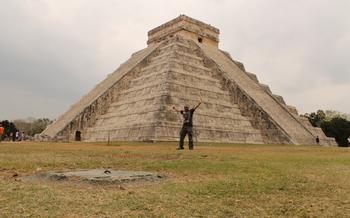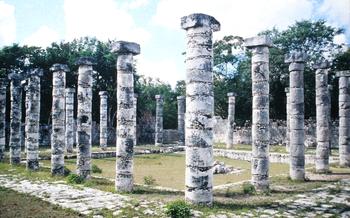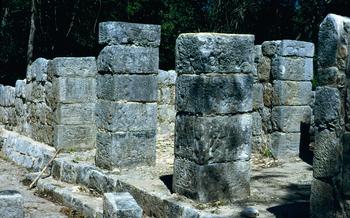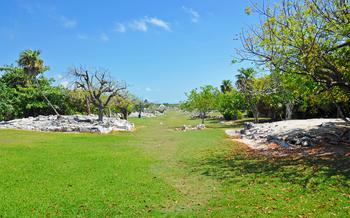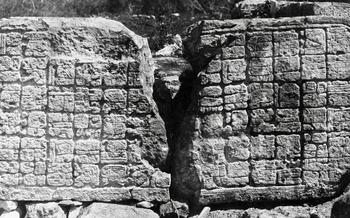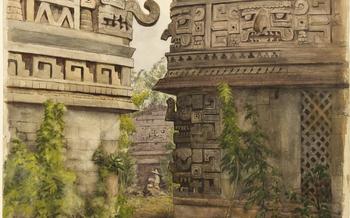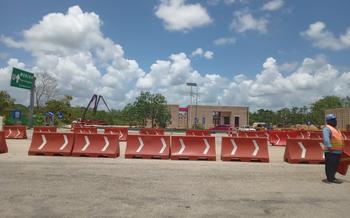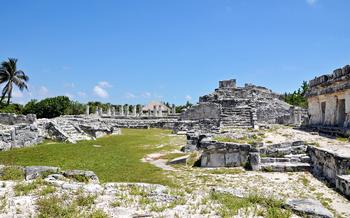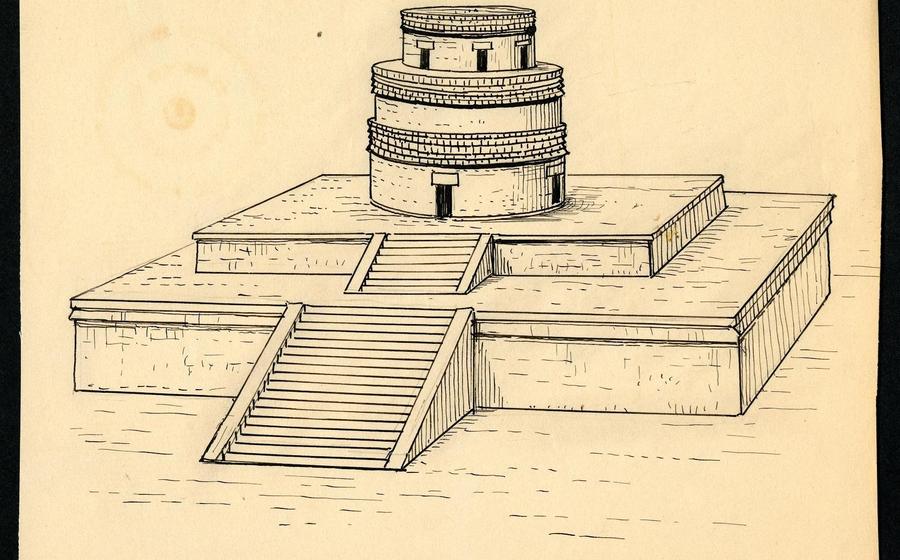
Cenote Xkeken
- Chichen Itza and the Cenote Xkeken: A Journey Through Time
- Decoding the Grandeur of Chichen Itza: El Castillo
- Unveiling the Sacred Cenote: A Portal to the Mayan Underworld
- Exploring the Enigmatic Ball Court: A Showcase of Mayan Sport and Ritual
- Venturing into the Temple of the Warriors: A Realm of Mayan Power and Prowess
- Discovering the Temple of the Jaguars: A Sanctuary of Feline Deities
- Strolling Through the Great Plaza: The Heart of Chichen Itza
- Decoding the Hieroglyphs: Unraveling the Mayan Script
- Learning About the Puuc Architectural Style: A Distinctive Mayan Aesthetic
- Sampling the Local Cuisine: A Culinary Journey Through Mayan Flavors
- Shopping for Souvenirs: A Memento of Your Chichen Itza Adventure
- Tips for a Hassle-Free Visit: Planning Your Day at Chichen Itza
- Insider Tip: Uncovering Hidden Gems Beyond Chichen Itza
Chichen Itza and the Cenote Xkeken: A Journey Through Time
Chichen Itza, a sprawling metropolis in Mexico's Yucatán Peninsula, and the nearby Cenote Xkeken offer a journey through time, revealing the grandeur of Mayan civilization and its deep connection to nature. Chichen Itza, with its iconic pyramid, El Castillo, served as the political and cultural hub of the Mayan world, while the Cenote Xkeken, a natural wonder, held immense religious significance. Planning a visit to both sites allows for a comprehensive exploration of Mayan history, culture, and spirituality. Respecting the cultural heritage and environment is paramount, ensuring the preservation of these remarkable treasures for generations to come.
Decoding the Grandeur of Chichen Itza: El Castillo
El Castillo (Kukulcán), the iconic pyramid of Chichen Itza, is a testament to the architectural prowess and astronomical knowledge of the ancient Mayans. Its towering presence dominates the site, attracting visitors from around the world.
Rising from the heart of the city, El Castillo stands as a symbol of the Mayans' deep connection to the cosmos. Its design and construction reveal a society that had mastered mathematics, geometry, and astronomy.
The pyramid is structured upon a square base and consists of nine levels, each adorned with intricately carved panels. These panels depict scenes from Mayan mythology, including the feathered serpent god Kukulcán, from whom the pyramid derives its name.
The most remarkable feature of El Castillo is its alignment with the sun during the spring and fall equinoxes. Twice a year, on March 21st and September 21st, the setting sun casts a shadow on the pyramid's northwest corner, creating an illusion of a serpent descending along the staircase. This phenomenon, known as the "Serpent's Descent," is a breathtaking spectacle that draws thousands of visitors each year.
El Castillo was not merely a ceremonial center but also served as an astronomical observatory. The Mayans used the pyramid's orientation and shadows to track the movements of the sun, moon, and stars. This knowledge was crucial for agricultural practices, religious rituals, and predicting celestial events.
Exploring El Castillo is a journey through time, connecting visitors to the rich cultural heritage and scientific achievements of the ancient Mayans. It is a monument that continues to awe and inspire, a symbol of their enduring legacy as one of the world's most advanced civilizations.
Unveiling the Sacred Cenote: A Portal to the Mayan Underworld
The Cenote Xkeken, located a short distance from Chichen Itza, offers a glimpse into the spiritual and ritualistic world of the ancient Mayans. This natural sinkhole, with its crystal-clear waters and towering limestone walls, was considered a sacred gateway to the underworld, Xibalba.
According to Mayan mythology, cenotes were portals through which the gods and ancestors could be reached. The Cenote Xkeken was particularly significant, as it was believed to be the entrance to the underworld city of Chichén Itzá, a mirror image of the earthly city above.
The Mayans performed elaborate rituals and ceremonies at the cenote, seeking guidance and protection from the gods. They believed that offerings made to the cenote would reach the underworld, ensuring the well-being of their community.
Archaeological excavations at the Cenote Xkeken have revealed a wealth of artifacts, including jade jewelry, gold ornaments, and human remains. These discoveries provide valuable insights into the religious beliefs and practices of the ancient Mayans.
The cenote's fragile ecosystem is home to a variety of aquatic plants and animals, including catfish, turtles, and bats. Visitors can swim in the refreshing waters of the cenote or snorkel among the ancient artifacts, creating a unique and unforgettable experience.
It is important to approach the Cenote Xkeken with respect and reverence, acknowledging its cultural and spiritual significance. Visitors should avoid disturbing the wildlife and refrain from removing any artifacts or disturbing the natural environment.
Exploring the Enigmatic Ball Court: A Showcase of Mayan Sport and Ritual
Amidst the sprawling ruins of Chichen Itza lies a testament to the Mayans' athleticism and ritualistic prowess—the Great Ball Court. This colossal structure, measuring 545 feet in length and 225 feet in width, is the largest of its kind in the ancient Mayan world. Its sheer size and grandeur hint at the significance of the ballgame in Mayan society.
The rules of the Mayan ballgame, known as pok-ta-pok, remain a subject of debate among scholars. However, it is believed that the game involved two teams of seven players who used their hips, shoulders, and elbows to keep a heavy rubber ball in play. The goal was to pass the ball through a stone ring attached to the wall of the court, a feat that required immense skill and coordination.
Beyond its sporting significance, the ballgame held deep religious and ritualistic meaning for the Mayans. It was believed to represent the cosmic struggle between day and night, light and darkness. The ball itself symbolized the sun, and the hoop through which it was passed represented the underworld. The outcome of the game was seen as an omen, and the winning team was often rewarded with lavish gifts and prestige.
The Great Ball Court at Chichen Itza is adorned with elaborate carvings and sculptures that depict scenes of the ballgame, as well as mythological figures and deities associated with the sport. These intricate artworks provide valuable insights into the cultural and religious significance of the game in Mayan society.
While the exact rules and symbolism of the Mayan ballgame may remain shrouded in mystery, the Great Ball Court stands as a testament to the Mayans' ingenuity, athleticism, and deep connection to their spiritual beliefs. Visitors to Chichen Itza are left in awe of this ancient arena, where echoes of a forgotten sport and ritual still linger in the air.
Venturing into the Temple of the Warriors: A Realm of Mayan Power and Prowess
The Temple of the Warriors is a captivating structure that stands as a testament to the power and prowess of the ancient Maya. Its imposing presence and intricate carvings offer a glimpse into the lives and beliefs of this enigmatic civilization.
Architectural Features and Symbolism: The temple showcases the distinctive architectural style of the Maya, characterized by its stepped pyramid form, corbelled arches, and intricate carvings. The facade is adorned with towering columns, each featuring a distinct warrior figure, their stoic expressions conveying a sense of strength and authority.
Ceremonial Center and Administrative Building: Beyond its symbolic significance, the Temple of the Warriors served as a multifunctional space. It functioned as a ceremonial center, where rituals and religious ceremonies took place, as well as an administrative building where important decisions were made. The temple's strategic location within the city suggests its role as a central hub for political and religious power.
Mayan Warriors and Their Stories: The temple's name pays homage to the brave warriors who were an integral part of Mayan society. These elite fighters were revered for their skills in battle and their unwavering loyalty to their city. Their heroic deeds and stories of valor were likely recounted within the temple's walls, inspiring future generations of warriors.
Impressive Collection of Sculptures and Artifacts: Numerous sculptures and artifacts have been discovered within the Temple of the Warriors, providing valuable insights into Mayan culture and beliefs. These include finely carved stone figures, ceramic vessels, and jewelry, all of which offer glimpses into the artistic prowess and daily lives of the Maya.
Discovering the Temple of the Jaguars: A Sanctuary of Feline Deities
Deep within the sprawling complex of Chichen Itza lies a sanctuary dedicated to the revered jaguar god, known as the Temple of the Jaguars. This sacred edifice holds a profound religious significance for the ancient Maya, who held the jaguar in high esteem as a symbol of power, strength, and the underworld.
The temple's architectural features and intricate symbolism reflect the profound reverence the Maya held for jaguars. Its facade is adorned with exquisite carvings and murals depicting jaguars in various poses, capturing their fierce beauty and regal presence. The interior of the temple reveals a series of chambers and passageways, each adorned with more jaguar motifs and other sacred symbols.
Within the temple, archaeologists have unearthed a wealth of artifacts and offerings, including jade figurines, ceramic vessels, and precious ornaments, all carefully placed as tributes to the jaguar god. These discoveries offer tantalizing glimpses into the rituals and ceremonies that took place within this sacred space.
The Temple of the Jaguars is not merely a historical monument but a testament to the Maya's deep connection to the natural world and their reverence for the powerful forces that governed their lives. It invites visitors to delve into the rich mythology and spiritual beliefs of this ancient civilization, reminding us of the enduring legacy of the Maya and their profound respect for the jaguar, a creature that embodied both the beauty and the power of the wild.
Strolling Through the Great Plaza: The Heart of Chichen Itza
In the heart of Chichen Itza lies the Great Plaza, a vast expanse that once served as the city's main gathering place. This awe-inspiring square, spanning over 200 meters in length, is bordered by some of the most iconic structures of the ancient Maya civilization. As you step onto the plaza, you can't help but be struck by its sheer size and grandeur.
The Great Plaza is a testament to the Maya's advanced engineering and architectural prowess. The surrounding structures, including the Temple of Kukulcan, the Temple of the Warriors, and the Great Ball Court, are arranged in a precise grid pattern, demonstrating the Maya's mastery of urban planning.
In ancient times, the Great Plaza was a bustling hub of activity. It hosted religious ceremonies, political gatherings, and vibrant markets. The air would have been filled with the sounds of chanting priests, the hum of conversation, and the laughter of children playing.
Today, the Great Plaza retains its sense of awe and wonder. Visitors from all over the world come to marvel at its imposing structures and imagine the vibrant life that once unfolded here. Whether you're standing in the center of the square, gazing up at the towering pyramid of Kukulcan, or exploring the intricate carvings on the Temple of the Warriors, you can't help but feel the weight of history and the enduring legacy of the Maya civilization.
Decoding the Hieroglyphs: Unraveling the Mayan Script
The Mayans developed a sophisticated writing system known as hieroglyphics, which played a crucial role in their communication and record-keeping. These intricate symbols, often carved into stone or painted on ceramics, conveyed a wealth of information about Mayan history, culture, and beliefs. Deciphering the Mayan script has been a challenging endeavor for scholars, but their tireless efforts have yielded significant insights into this ancient civilization.
The process of deciphering Mayan hieroglyphs involved a combination of linguistic analysis, archaeological research, and epigraphical studies. Early attempts to understand the script focused on comparing Mayan texts with known languages, such as Spanish and Nahuatl. However, it wasn't until the mid-20th century that significant breakthroughs were made. Russian scholar Yuri Knorozov played a pivotal role in deciphering the phonetic values of many hieroglyphs, paving the way for a deeper understanding of the Mayan language.
Through the painstaking work of epigraphers and linguists, the Mayan script has gradually been decoded, revealing a rich tapestry of historical accounts, religious beliefs, astronomical observations, and everyday life. Hieroglyphs have been found on a wide range of artifacts, including stone monuments, ceramics, and codices, providing invaluable insights into the minds and lives of the ancient Mayans.
The ongoing study of Mayan hieroglyphs continues to shed light on the complexities of this ancient civilization. Epigraphers are working to decipher new texts, while archaeologists are uncovering more artifacts that bear these enigmatic symbols. The preservation and study of hieroglyphs are essential for understanding the rich cultural heritage of the Mayans and their enduring legacy in the world.
Learning About the Puuc Architectural Style: A Distinctive Mayan Aesthetic
Chichen Itza is a testament to the architectural prowess of the ancient Maya, showcasing the distinctive Puuc style that characterized many of their cities. This style is evident in the intricate stone carvings, decorative elements, and overall design of the buildings. The Puuc style is characterized by its use of corbels, which are triangular stones that support the weight of the roof, and by its elaborate friezes, which are bands of decoration that run along the tops of the walls.
The most striking example of Puuc architecture at Chichen Itza is the Temple of the Warriors, which is adorned with intricate carvings depicting scenes from Mayan mythology and history. The temple also features a series of corbels that support the roof, as well as a frieze that runs along the top of the walls. Other notable examples of Puuc architecture at Chichen Itza include the Temple of the Jaguars and the Great Ball Court.
The Puuc style is believed to have originated in the Puuc region of the Maya lowlands, which is located in present-day Yucatan, Mexico. The style was later adopted by the Maya of Chichen Itza, who incorporated it into their own architectural traditions. The Puuc style is a significant part of Maya cultural heritage, and it continues to inspire architects and designers around the world.
Sampling the Local Cuisine: A Culinary Journey Through Mayan Flavors
Indulge in the tantalizing flavors of Mayan cuisine, a culinary journey that is as rich and diverse as the region's history and culture. From the smoky, slow-roasted cochinita pibil to the flavorful panuchos with their crispy tortillas, each dish is a testament to the ingenuity and creativity of the Mayan people.
Discover the unique ingredients that give Mayan cuisine its distinctive character, such as achiote, a vibrant red spice that imparts a smoky flavor to dishes, and chaya, a leafy green with a slightly bitter taste. Savor the freshness of locally-sourced ingredients, from the succulent seafood of the Yucatán coast to the fragrant herbs and spices grown in the region's fertile soil.
Support the local economy and connect with the community by dining at traditional markets and restaurants. Sample the street food, a vibrant tapestry of flavors and aromas, and immerse yourself in the lively atmosphere of these culinary hotspots. For those with dietary restrictions, vegetarian and vegan options are widely available, ensuring that everyone can enjoy the delights of Mayan cuisine.
Shopping for Souvenirs: A Memento of Your Chichen Itza Adventure
Chichen Itza offers a diverse array of souvenirs, from intricate handicrafts to replicas of ancient artifacts, providing visitors with a tangible reminder of their journey.
-
Handcrafted Souvenirs: These items, such as woven textiles, pottery, and wood carvings, are created by local artisans using traditional techniques. They often incorporate Mayan motifs and symbols, making them unique and authentic souvenirs.
-
Replica Artifacts: For those seeking a piece of history, replicas of Mayan artifacts, such as jade carvings, obsidian blades, and ceramic figurines, are available. These replicas are often meticulously crafted and provide a glimpse into the artistic and cultural achievements of the ancient Maya.
-
Bargaining Tips: Bargaining is a common practice in Chichen Itza. Don't be afraid to negotiate prices with vendors, but do so respectfully and with a smile. Remember that the vendors rely on tourism for their livelihood.
-
Supporting Local Artisans: By purchasing souvenirs from local artisans, you directly support their livelihoods and help preserve traditional Mayan crafts. Look for items that are handmade and bear the artist's signature or stamp of authenticity.
-
Packing Your Souvenirs: Pack your souvenirs carefully to ensure they make it home safely. Fragile items should be wrapped in bubble wrap or tissue paper and placed in a sturdy container. Consider using a carry-on bag for valuable or breakable items.
Tips for a Hassle-Free Visit: Planning Your Day at Chichen Itza
Visiting Chichen Itza can be an enriching and memorable experience, but careful planning ensures a smooth and enjoyable day. The best time to visit is during the shoulder seasons (April-May and September-October) to avoid the peak tourist crowds. Arriving early in the morning is also advisable to beat the heat and capture the best light for photography.
Make sure to pack essentials like sunscreen, insect repellent, a hat, and comfortable shoes suitable for walking on uneven surfaces. Bring plenty of water, as there are limited options for purchasing drinks on-site. Hiring a certified guide or joining a guided tour is highly recommended to gain in-depth insights into the history and significance of the site.
Remember to be respectful of the local culture and customs. Dress appropriately, avoiding revealing clothing, and refrain from climbing on the ruins or touching the artifacts. Photography is generally permitted, but using a flash or tripod may be restricted in certain areas.
Plan your visit to allow ample time to explore the main attractions, including El Castillo, the Cenote Xkeken, the Great Ball Court, and the Temple of the Warriors. Take breaks to rest and hydrate, especially during the midday heat. You can also enjoy a delicious Mayan-inspired lunch at one of the restaurants or cafes located near the entrance of Chichen Itza.
Insider Tip: Uncovering Hidden Gems Beyond Chichen Itza
While Chichen Itza is undoubtedly a must-visit destination, there are other hidden gems in the region that are equally captivating. For those seeking further exploration, here are a few recommendations:
-
Cenotes Ik Kil and Suytun: Just a short drive from Chichen Itza, these two cenotes offer a refreshing and enchanting experience. Swim in their crystal-clear waters, surrounded by lush vegetation and ancient rock formations.
-
Uxmal, a UNESCO World Heritage Site: Located about an hour from Chichen Itza, Uxmal is another ancient Mayan city that boasts impressive architecture and history. Explore its well-preserved pyramids, temples, and plazas, and immerse yourself in the grandeur of this once-thriving metropolis.
-
Valladolid, a Colonial City: Step back in time as you wander through the charming streets of Valladolid, a colonial city located near Chichen Itza. Admire its colorful buildings, visit the local markets, and soak up the vibrant atmosphere of this historic town.
Remember, the beauty of travel lies in exploring beyond the popular tourist destinations. By venturing off the beaten path, you'll discover hidden treasures that will enrich your understanding of the region and create lasting memories.
